Use my versatile All-Purpose Miso Sauce to make glazes, marinades, dressings, and dipping sauces. This sweet and savory sauce is the secret to many of your favorite Japanese dishes. Add it to any protein or vegetable for a boost of authentic umami flavor. This vegan-friendly sauce is super easy to put together with just four ingredients.
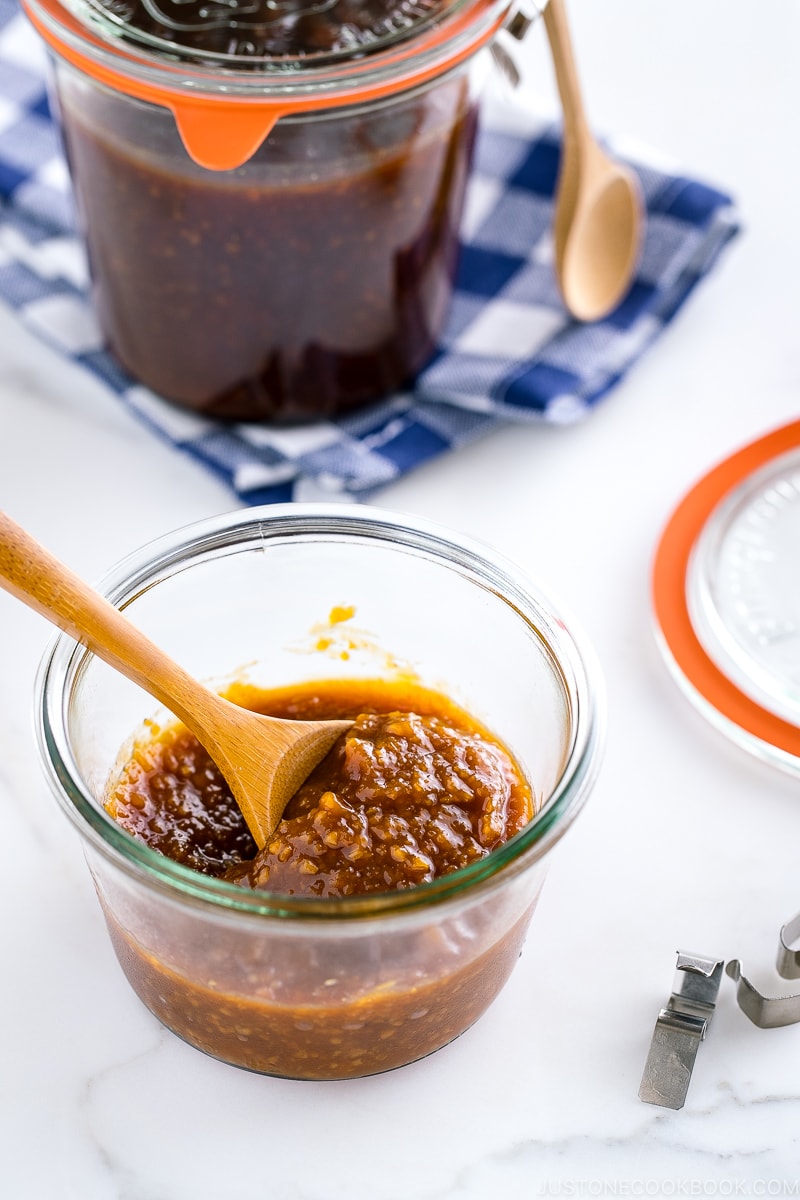
It’s always good to have homemade sauces around in your kitchen so you don’t end up with the store-bought stuff. Not only you have complete control over the ingredients, but a homemade sauce always tastes so much better. Today I’m sharing my secret magic sauce: the brilliant All-Purpose Miso Sauce.
Whether it is to add a little depth or complexity, this miso sauce never fails to jazz up a dish whenever something is amiss. Just like a reliable friend you can count on anytime!
The Best Miso Sauce
5 reasons to love this sauce:
- It’s full of authentic Japanese flavor. The sauce is the guarded secret to many of your favorite Japanese dishes.
- Super easy to put together & only 4 simple ingredients needed!
- Long shelf life. Make once and store well in the fridge for up to 2 months.
- Its ability to transform. You can get a whole variety of homemade sauce with varying flavors by using different miso. Mild, sweet or pungent – you decide.
- Unlike bottled seasoning sauces, this homemade sauce is free of processed ingredients and MSG (monosodium glutamate).
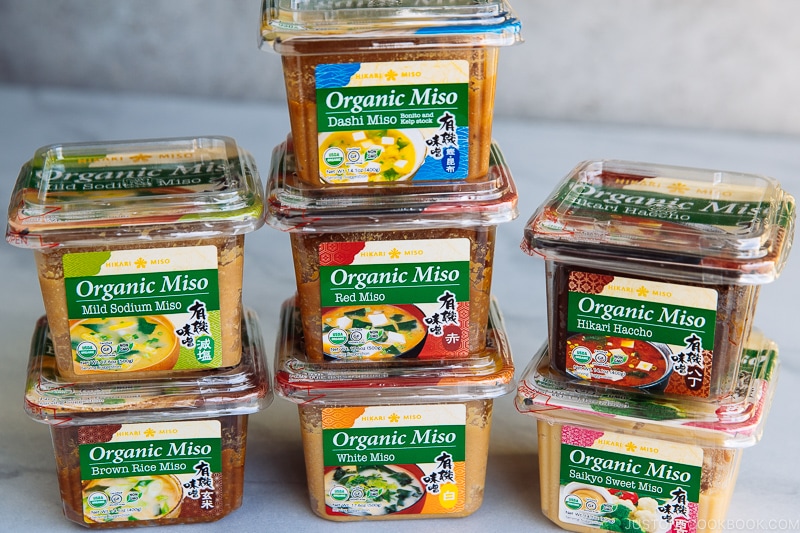
3 Things to Know When Making All-Purpose Miso Sauce
1. Saltiness varies based on the miso brand/type
If you’re using a different brand or type of miso, keep in mind that the saltiness level may differ from my recipe. So adjust accordingly.
2. Different types of miso yield different flavors
Miso can be made of rice, barley, soybean, or koji, and each one has different strengths and depth. Just like saltiness, if you’re using a different type of miso, your homemade miso sauce may not taste exactly like mine. It also means you can literally make a variety of this sauce by using different types of miso.
3. Miso burns easily
Miso itself burns easily while cooking, but it gets even more susceptible when you include mirin and/or sugar. Be sure to keep a close eye of the pot. Stay around to scrape the bottom of the pot and keep stirring.

Recipe Ideas with All-Purpose Miso Sauce
- Marinade: Use different proteins including fish, chicken, pork, beef, and tofu. Cook in the foil, oven or pan fry.
- Stir Fry: Add just a tablespoon or two of the miso sauce to the stir-fry dishes.
- Simmered Dishes (Nimono): Simmer root vegetables and protein with miso sauce.
- Dipping Sauce: for your steamed vegetables, hot pot, or simply, fresh cucumber.
- Dressing: Coat with all kinds of vegetables and add them to the salad dressing base.
Sweet, savory, versatile, and full of umami, that’s what makes this All-Purpose Miso Sauce so brilliant. I know you’d have fun integrating the sauce into more of your cooking.
Recipe Ideas:
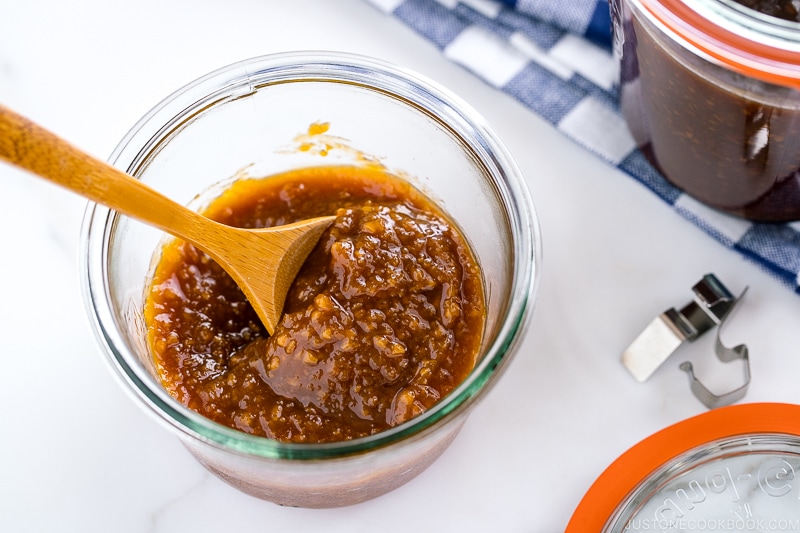
Wish to learn more about Japanese cooking? Sign up for our free newsletter to receive cooking tips & recipe updates! And stay in touch with me on Facebook, Pinterest, YouTube, and Instagram.
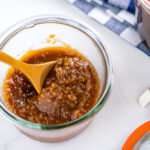
All-Purpose Miso Sauce
Instructions
- Gather all the ingredients.
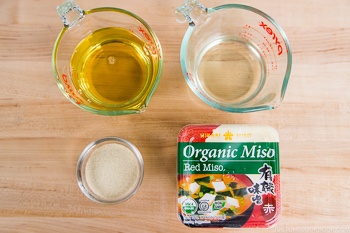
- Add 1 cup miso, 1 cup mirin, ½ cup sake, and 2 Tbsp sugar to a small saucepan.
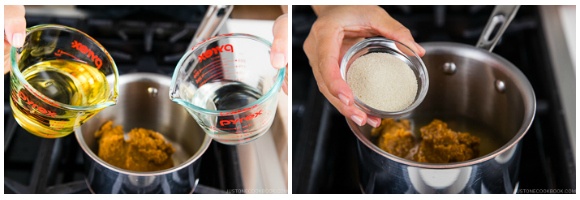
- Whisk it all together. Set the pot on the stove and bring the sauce to a boil over medium heat.
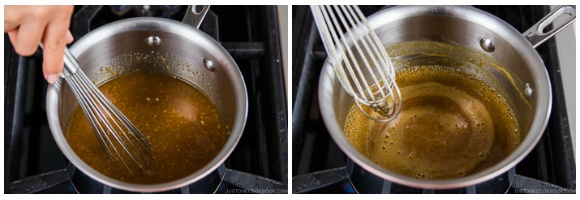
- Once bubbling, reduce the heat to low. Keep stirring and scraping the bottom of the pot to prevent the sauce from burning. Simmer for 20–30 minutes until thickened. Your miso sauce is now ready to use.
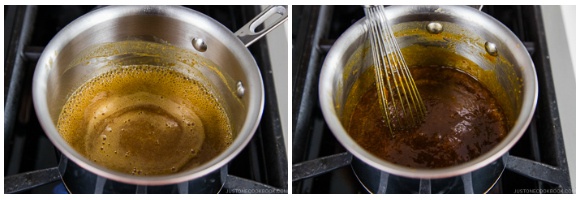
To Serve
- Enjoy this All-Purpose Miso Sauce as a marinade for protein like chicken thighs in my Miso Chicken recipe. You can also use it to make my delicious Tahini Miso Dressing to serve with all kinds of vegetables and salads like my Roasted Cauliflower Kale Salad.

To Store
- Transfer the sauce to an airtight container and let it cool completely. Close the lid and store in the refrigerator for up to 2 months.
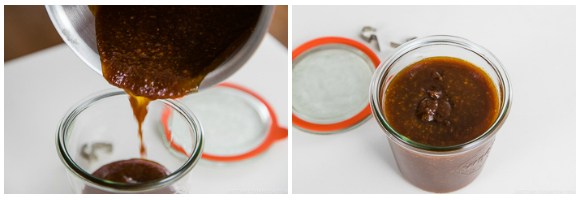
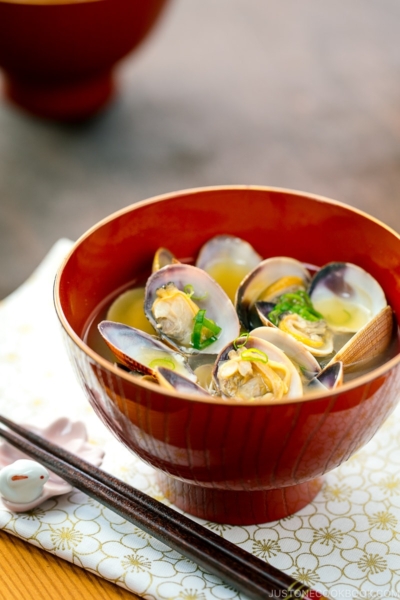







How many tablespoons / what is the weight of 1 cup of miso. I’m looking for UK measurements
Hi Zoe, Thank you so much for trying Nami’s recipe!
1 US cup = 16 US tablespoons
1 US cup Miso is 288g
For Metric measurements, please click the “Metric” box in the ingredient list, and it will convert it for you. 🙂
We hope this helps!
Hello, I was wondering if I could replace the sake for water in this recipe
Hi Pat! Thank you so much for reading Nami’s post and trying her recipe!
Yes, water can be used in place of Sake, but the umami flavor of Sake will be missed. In addition, we recommend using the sauce within a week.
We hope this helps!
Hi, Namiko, what portion of the sauce are you using to determine the nutritional value of sodium of 34mg? Obviously, that’s not the amount of sodium for the full recipe since just 1 TBSP of the miso I want to use is more the 840mg.
For myself, it really doesn’t matter but I have to cook for an individual who has to watch her sodium intake and that’s why I’m asking.
BTW, for Japanese recipes, your website is one of the few GO-TO sites. Being from Okinawa, I really appreciate the fact that you also have some Okinawan recipes, too! 😀
Hi Masao! Thank you for reading Nami’s post and trying her recipe!
Nami and all of us at JOC are so happy to hear our website is one of your go-to sites. 🥰 It makes us extremely happy.
As shown in the chart, the nutritional value of this recipe is 1 ml. For reference: 1 Tablespoon = about 15 ml
We hope this helps!
Why on earth would you BOIL miso?! It ruins the flavours.
Hi Lily! Thank you for reading Nami’s post and trying her recipe!
Yes. Miso flavor is the best if it doesn’t get to boil, and we don’t recommend bringing it to the boiling point when making Miso soup. However, to make a sauce, baking dishes, etc., it will reach a higher temperature sometime, but the flavor is mixed with other condiments, and taste and flavor would be more than Miso.
We hope this helps!
I’m curious: might this recipe be used as a miso tare for ramen? What do you think?
Hi, A Kat! This sauce is on the sweet side. For Ramen, you might want to adjust the flavor with other ingredients. But it’s totally up to your preference!😉
Let us know how it goes!
I just made the sauce and it turned out very salty. Do you think I can still save the sauce? I’m wondering if I should add more mirin and sake and go through the simmering process again?
Hi Jason! Thank you very much for trying Nami’s recipe!
If you like to add more mirin and sake, you can do that and simmer it again. However, the balance of the flavor might need to adjust. You can also save the sauce as is and use it as condiments. Use this All-Purpose Miso Sauce to make simple glazes, marinades, dressings, or dipping sauces.
We hope this helps!
Hi Nami! Great recipe – mine came out good. Can I freeze this all purpose miso?
Hi Luz! Thank you very much for reading Nami’s post and trying her recipe!
Yes, you can freeze this. But it would not be hard frozen because of Miso.
We hope this helps!
Can miso broth be used if that is the only thing available?
Hi Natalie, Thank you very much for trying Nami’s recipe!
Miso broth contains Dashi, and it will not last long if you use it in this recipe. And if you are replacing the Miso amount with Miso broth, it will be more waterly and need to adjust the other ingredients. So we hope you can find Miso paste instead.
This is a great recipe. I’m on a low acid diet so I mixed it with some mayonnaise and it makes a great salad dressing or veggie dip.
Hi Pam! What a great idea! Thank you for trying this recipe and sharing your cooking experience with us!
Hi Nami,
What can I substitute sake and mirin with? This sauce looks great!
Thanks
Dorothy
Hi Dorothy! Thank you very much for reading Nami’s post!
Here are links where Nami explains how to substitute condiments. We hope this helps!
https://www.justonecookbook.com/mirin/
https://www.justonecookbook.com/sake/
Hi Nami! Loved the sauce although mine had a bitter after taste. I must’ve burned the miso by accident. Any remedies? 🙁
Hi Eli, Thank you for trying this recipe. We are sorry to hear that it has a bitter burned taste.
The burnt taste and smell are not easy to cover up. Maybe you can add a little soy sauce to it..? We hope it works.
While in Japan I ate a hot dipping sauce for vegetables. The most we could understand was that it was made with barley miso. Do you happen to have a recipe for a hot barley miso veggie dip? It was unforgettable. I am going to try this recipe for miso sauce, just wondered if you might know of a barely miso recipe. Great blog. Love it.
Hi Roberta, Thank you very much for your kind feedback! We currently have non-spicy miso sauce like this one on the site. They have many different Miso Sauce types in Japan, and not sure which hot dipping sauce you enjoyed in Japan. It may have Japanese red hot pepper, Karashi (Japanese mustard), or Asian hot sauce in the Miso Sauce.
If you use Barley Miso for this recipe and add your favorite spice, you may find the taste you enjoyed in Japan. We hope this helps!
I tried it out but my sauce is more liquid than creamy and i used your meassurements….(in ml) hmm
Hi Danica, Thank you very much for trying this recipe! This sauce needs to reach the point that you see bubbling (Step 4), then reduce the heat to low and simmer for 20-30 minutes until thickened. So if you put back your sauce in the pot and heat up again, and simmer (low heat), it should be fine. We hope this helps!
I have made the miso sauce and am excited to use it! Would it be a good marinade for a flank steak? If so, how would you use it to do this, (ie mix with sake or vinegar, etc), and how long would you marinate for?
I have used several of your recipes and am very pleased with how well they turned out–especially because my husband and son enjoyed them so much!
Hi Heather, Thank you very much for trying many of Nami’s recipe. If you would like to use it as a marinade, marinate the beef with just a small amount of AP miso sauce and REMOVE the miso COMPLETELY before cooking. (because miso burns really easily.) Then You can heat the sauce and drizzle a bit before serving. We hope this helps!
The recipe suggests “Use this All-Purpose Miso Sauce to make simple glazes”. What’s the difference between this miso sauce and a miso glaze? If there is a difference how do you make the glaze?
Hi JC, They are the same recipe, but how you use it is the difference. The glaze is formed by thickening the sauce so that it turns into a shiny concoction that can be brushed on cooked or raw meat to enhance the flavor. The sauce may be used as a quick marinade to grill or bake fish or seafood. We hope this helps!